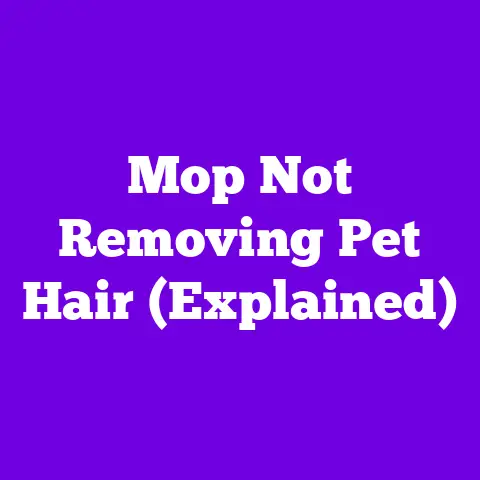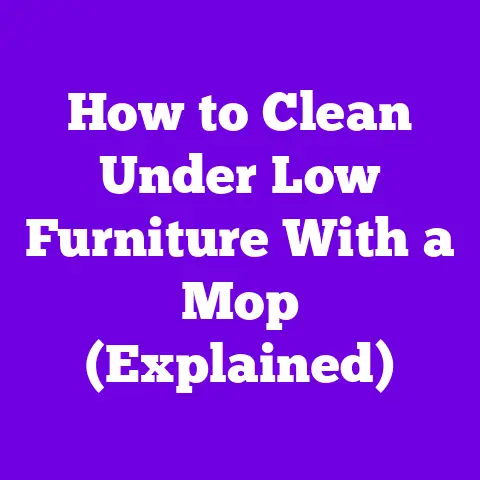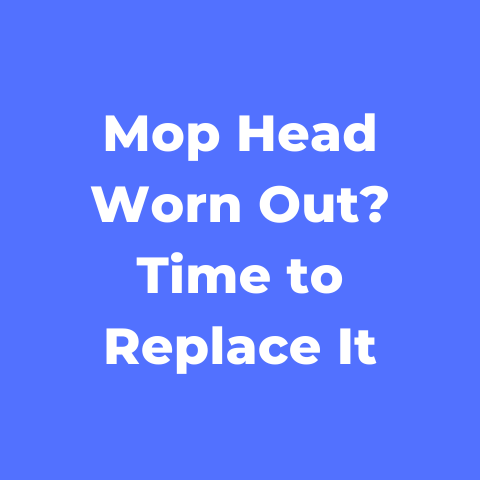How to Make My Mop Last Longer (Explained)
Keeping floors clean is an important part of maintaining a healthy home. However, going through mops quickly can get expensive. Learning how to make your mop last longer saves you both money and time spent frequently replacing your mop.
Choose the Right Initial Mop
Your mop type greatly impacts its durability. Consider these factors when purchasing a new mop:
Mop Material
The most durable mop materials are:
- Microfiber – Made of finely woven synthetic fabric, microfiber mops last through frequent washing with minimal fraying. They effectively pick up dust and dirt.
- Cotton – Natural cotton mops with tight weaves are highly absorbent and stand up well to washing. They tend to be more expensive but last for years.
- Blend – Blended mops combine synthetic and natural fibers to provide durability with absorbency. They offer a balance of affordability and longevity.
Mop Weight and Design
Heavier mops require less pressure when cleaning, putting less strain on materials. Metal or sturdy plastic handles last longer than flimsy plastic handles prone to cracking.
Intended Floor Type
Match your mop to floors you’ll use it on. For example:
- Tile and vinyl floors => string or flat mops
- Hardwood floors => microfiber mops
- Carpets and rugs => specialized carpet mops
Getting the right mop style maximizes efficiency while minimizing undue wear and tear during cleaning sessions.
Proper Mop Use
How you use your mop also determines its lifespan. Follow these best practices whenever mopping:
Prepare Floors Beforehand
Sweep floors first to remove loose debris and dirt that can quickly dirty mop water. This prevents repeatedly rinsing out filthy mop heads unnecessarily.
Use Correct Amounts of Cleaner
Too much or too little cleaning solution wears out mops faster:
- Too much – Overly saturated mops cause excess dirt and soap buildup in fibers. Rinse mops after finishing floors.
- Too little – Using a mostly dry mop head requires more scrubbing pressure, straining materials. Dampen mops adequately.
Follow cleaner product instructions to use the right dilution ratios and coverage areas per tank size.
Let Mops Fully Dry
Leaving any mop damp promotes mold, mildew, and bad odors in the fibers. Fully wring out mops after use and allow to completely air dry before stowing vertically to maximize airflow.
Don’t Use Harsh Chemicals
Avoid cleaners containing toxic ingredients like bleach, ammonia, or alcohol that degrade mop fabrics more quickly. Use mild, eco-friendly solutions instead.
Extend Mop Life Through Proper Care
Caring for your mop properly makes a significant difference in its durability. Here are impactful maintenance tips:
Frequently Wash Removable Mop Heads
Launder string, sponge, and microfiber mop heads in washing machines weekly. This prevents dirt, hair, and soap accumulating to damage fibers. Use hot water cycles for sanitization.
Hand Wash Fixed Mop Heads
Mops with permanent heads require hand washing. Rinse under warm water while gently massaging cleaner through the fibers. Repeat washes may be needed for heavily soiled mops.
Disinfect Mops to Prevent Mold
Sanitize all mops occasionally to kill mold and bacteria. First wash the mop head normally, then soak it for 5-10 minutes in:
- 1 cup bleach + 1 gallon water
- Vinegar solution
- Other commercial cleaners like Lysol
Rinse thoroughly afterwards.
Air Dry Upside Down
Always dry mops with heads facing downwards. This shape helps water drain out instead of settling into the fibers. Lay mops on absorbent towels to wick moisture too.
Detangle String Mops
For string mops, gently loosen and separate fibers while drying to prevent knotting and tangling that strains the strands.
Replace Worn Parts Quickly
At the first sign of damage, fix or replace mop parts like loose head bands or tearing fabric edges. This prevents bigger failures needing total mop replacement.
Solutions for Specific Mop Issues
Targeted solutions can revive mops exhibiting certain problems:
Smelly Mop Heads
Bad odors mean bacteria or mold is growing in the fibers. Disinfect smelly mops with bleach, vinegar, or other anti-microbial cleaners to kill contaminants and eliminate smells.
Torn or Fraying Fabric
Try sealing small tears or loose strands with fabric glue applied along the severed fabric edge. For bigger damage, replace detachable mop heads.
Loose or Broken Mop Handles
Re-secure loose screws or fasteners on metal mop handles. For cracked plastic handles, wrap sturdy tape around the break if possible. Otherwise replace broken handles.
Mops Missing Strands
Trim loose filaments around thinning spots to prevent bigger holes from developing. Avoid harsh scrubbing at worn areas by using gentler mopping motions.
Dirty, Gunky Buildup
Tackle stuck-on dirt, soap scum, and oily residues with targeted spot cleaning:
- Grease – Dish soap, baking soda paste
- Soap scum – Vinegar solution
- Dirt – Laundry detergent, oxiclean
Check mop care tags before applying any solvents.
Preventative Measures
Implementing ongoing prevention habits maximizes the lifespan of every mop you own:
Rinse After Each Use
Give mops a quick rinse under running water to remove surface dirt and cleaning product residue after mopping floors.
Alternate Different Mops
Rotate using 2-3 mops rather than relying on just one. This distributes wear and tear across multiple mops instead of a single overused mop prone to faster breakdown.
Hand Wash Delicates
For specialty mops like reusable electrostatic types, follow manufacturer care instructions for hand washing only. Machine washing risks damage to the microfiber fabric or internal charging wires.
Inspect Frequently
Check mops after each use and launder cycle for any developing signs of damage. Catch issues early before they worsen.
Air Dry Thoroughly
Never put away damp mops. Ensure they dry completely before storage to prevent mold, odors, and rotting.
Store Properly
Hang mops vertically by looped handles instead of laying flat. Keep out of direct sunlight and avoid compressing mop heads.
Following these preventative steps makes each mop last exponentially longer through reduced staining, wear, moisture damage, and grime buildup over time.
Frequently Asked Questions
Still have questions? Here are expert answers to common mop durability issues:
Can I machine wash microfiber mops?
Yes, you can machine wash microfiber mop heads to remove dirt and stains. Use hot water and an extra rinse cycle. Line or air dry instead of machine drying to prevent damage from excess heat.
How do I get bad smells out of a mop?
Eliminate odors by disinfecting smelly mops with bleach, vinegar, or other antimicrobial solutions. Ensure mops dry fully before using or storing them again. Replace mops with persistent bad smells.
Why does my mop keep fraying?
Fraying happens from using harsh scrubbing motions that strain mop fabric. Also overly saturated mops fray more easily. Wring out excess water and use gentle mopping techniques to prevent fraying.
Should I rinse my mop every time?
Yes, rinse mops after each use. Mop heads left damp attract dirt faster next use. Rinsing prevents residue buildup that degrades mops quicker. It takes seconds but makes mops last much longer.
Can I fix a cracked plastic mop handle?
Wrap sturdy tape around cracked handles to reinforce and prevent further damage. Look for fiberglass tape or extra strong duct tape. If cracks are too large, replace the broken handle for safety and performance.
Use the actionable advice provided to troubleshoot current mop problems and prevent future damage. Know exactly what to look for when buying your next mop. Most importantly, develop consistent habits that extend the durability of all your cleaning tools. Keep your mops in top working condition for as long as possible!






